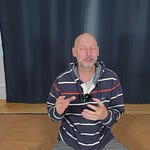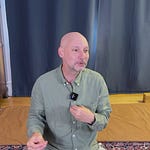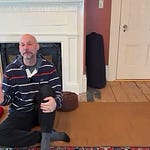Dear reader,
I’ve just returned to my home in Maine after a long stretch of limbo, and I’m in the throes of settling in. Unpacking boxes, lighting candles, reclaiming rhythms. For this reason, I’m offering just one practice this week.
Thank you for your patience—and for walking with me through so many thresholds of transition. This post, like the practice it accompanies, is about tending that inner hearth: the fire that somehow survives upheaval and helps shape what comes next.
In last Sunday’s reflection, I explored the collapse of forms and the laughter that endures. This week’s Yin Practice turns toward something quieter, but no less powerful: the ritual of rebuilding. More precisely, the inward fire that makes such rebuilding possible—the inner flame of sacred awareness.
Long before yoga studios and mats, before posture sequences and playlists, there was fire. In Vedic India (circa 1500 BCE), spiritual practice centered around Agni, the fire god—the divine intermediary between humans and the cosmos. Priests would tend the flames and offer ghee, grain, and mantra to uphold the sacred order. These early fire rituals were not symbolic; they were cosmological acts, whereby making an offering to fire was to participate in the rhythmic ordering of the universe itself.
But something shifted around 800-600 BCE. Some folks left the villages and temple hearths behind. These were the aranyakas—the forest dwelling ascetics—who turned their gaze inward, seeking direct communion with the Divine without the need for external sacrifice. From their inquiries emerged the Upanishads, and with them, a radical inner fire: tapas, the heat of disciplined attention, the flame of inquiry, the sacred burning of what is false in service of what is true.
As the Chandogya Upanishad put it:
"There is a light that shines beyond all things on earth, beyond the highest heavens. This is the light that shines in your heart."
This is our inheritance.
Each time we step onto the mat or into stillness, we become descendants of those who tended not just the outer flame, but the one within. We place our bodies like offerings on the altar of the earth,and without words we make a vow, remembering that attention itself is sacred.
Whether or not you light a candle, the fire is already lit.
This week’s Yin Practice Lab invites you into that lineage. In the 30-minute session, we shape the body as one might arrange sacred objects on a shrine—deliberately, respectfully, with care. And in the quiet that follows, and let the altar do its work. Openly, receptively, with care
After the postures, I’ll leave you in a seat of meditation. Stay as long or as briefly as you like. But please—don’t divide the sacred. Don’t mark meditation as the “real” part, with before and after as filler. The fire doesn’t only burn on the cushion. It burns in your walk to the sink. In your conversations. In the griefs you carry and the bread you toast. Once tended, the flame begins to reveal itself everywhere.
That is the slow miracle of practice: it doesn’t remove the ash. It warms it.
Warmly,
Josh
A Note About Supporting This Work
If you found this practice meaningful, consider sharing it with a friend. And if you’d like to receive these reflections and practices every week, becoming a paid subscriber is the best way to support this work—and to walk with me in this rhythm.
Each week, I offer original essays and meditative Yin Yoga sessions that thread together myth, grief, embodiment, and presence.
Thank you for your support and practice!













Share this post